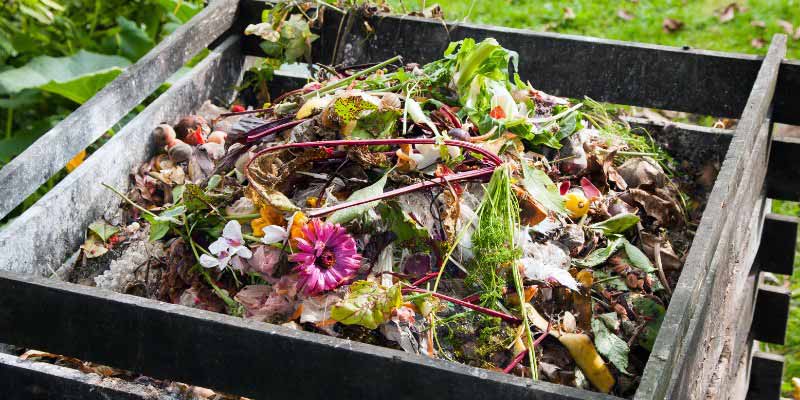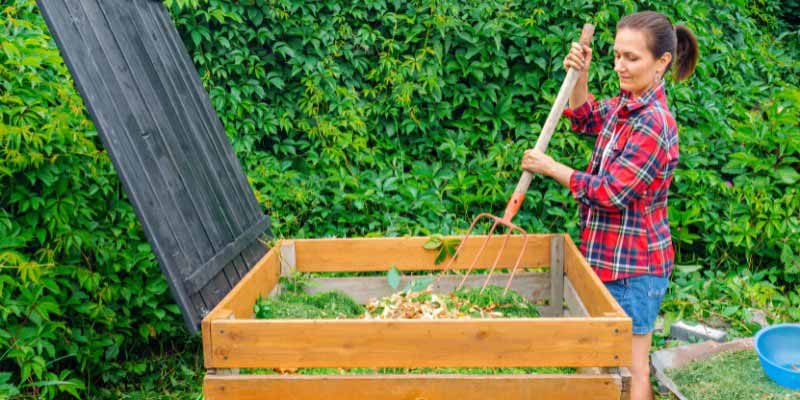Do you want to reduce your waste while enriching your garden? Home composting is the perfect solution! Since January 2024, composting organic waste has become obligatory for all households in France. A simple, ecological, and effective gesture when you consider that organic waste accounts for between 40% and 60% of our household rubbish. Want to get started but don't know where to begin? Which composter to choose? What waste to compost? How to properly maintain your compost? In this tutorial, discover how to make your first home compost in 5 simple steps, along with all the tips to obtain a rich and balanced soil.
What is composting?
Compost is the result of composting, which is the natural decomposition of organic materials such as peelings, dead leaves, or grass clippings. Under the action of microorganisms (bacteria, fungi) and small soil creatures (earthworms, insects), these waste materials transform into a dark, crumbly substance rich in nutrients. It is called "the gardener's black gold" because it improves soil quality, promotes plant growth, and helps retain moisture.
Which composter to choose?
The choice of composter depends on the space you have and your lifestyle. If you have a garden, opt for a classic composter, preferably made of untreated wood or plastic, with a capacity suited to the size of your household. You can also choose to compost in a heap, directly on the ground, which facilitates exchange with the microorganisms present in the soil. If you live in an apartment, a worm composter (or vermicomposter) is ideal: compact, odourless, it uses worms to speed up decomposition. There are also balcony composters or mini-composters, like the Bokashi composter, specially designed for small spaces.

What to put in the compost?
Wondering what waste to compost for good compost? A successful compost relies on a good mix of organic waste. Here is the list of materials you can put in your compost without worry and those to avoid:
Compostable waste:
?♻️Green materials (rich in nitrogen):
Kitchen waste
- Vegetable and fruit peelings (even citrus cut into small pieces)
- Crushed egg shells
- Leftovers (excluding meat, bones, fish)
- Cheese rinds
- Coffee grounds and tea bags (without staples)
Garden waste
- Cut or wilted flowers
- Weeds (without seeds)
- Leaves
- Grass clippings in small quantities
- Chipped branches
- Bark, straw, wood chips
?Brown materials (rich in carbon):
- Dead leaves
- Unprinted brown cardboard (torn into small pieces)
- Unbleached paper (newspaper, paper towels without chemicals, tissues)
- Wood chips, untreated sawdust
- Chopped branches, twigs
Waste to limit, avoid, or prohibit:
- For healthy and effective compost, avoid waste that can cause bad odours, attract pests, or disrupt decomposition. This includes meat, fish, shellfish, as well as greasy leftovers. Breads/pastries should also be limited, as they slow down the process or attract unwanted guests. Also avoid: weeds with their seeds, which may germinate, and diseased plants.
- Some waste is toxic or non-biodegradable: chemicals, plastics, metals, diapers or non-plant-based animal litter. In summary: if it’s not natural and easily degradable, it’s better to skip it! To be sure not to make mistakes, consult our sheet Organic waste: what can be composted?

How to make your first compost: the 5 steps
The necessary materials
- A composter (wooden bin, plastic, or simple heap outside)
- A fork or a compost aerator (to regularly mix)
- A bucket (to easily collect your organic waste before emptying it into the compost)
- Gardening gloves (handy for handling materials)
1. Choose the right location
Install your composter in a corner of your garden, preferably in the shade or partial shade to prevent it from drying out too quickly in summer. The composter should be placed in an easily accessible location, neither too far nor too close to the house. The goal is to make composting practical and enjoyable, without it becoming a chore every day!
2. Prepare the right waste
The secret to successful compost is the balance between "green" and "brown" materials. Count 2/3 of "brown" for 1/3 of "green". Green materials are rich in nitrogen (fruit and vegetable peelings, coffee grounds, grass clippings), while brown materials provide carbon (dead leaves, unprinted cardboard, twigs). To facilitate decomposition and speed up the composting process, it is better to cut or shred the waste into small pieces before adding them to the compost.
The secret? Alternate layers of green and brown materials to promote harmonious decomposition. Too much green material makes the compost wet and smelly, while an excess of brown material makes it too dry and slows down the process. Balance is the secret to compost!

3. Aerate regularly
The compost needs oxygen to decompose properly. Without aeration, it risks rotting, emitting bad odours, and slowing down its transformation. If you leave it too compact, it will suffocate and emit unpleasant smells.
- Mix it regularly with the fork or aerator, about every 2 to 3 weeks to ensure good aeration.
- Add coarse materials like small branches to facilitate air circulation and prevent it from compacting too much.
- A well-aerated compost gives off a pleasant woodland smell… and not that of a forgotten bin.

4. Monitor the moisture
Compost that is too wet can rot and emit a bad smell, while dry compost will slow down its transformation. The good indicator? A material that has the texture of a wrung-out sponge. Adjust the moisture by adding wet or dry waste as needed.
- Too dry? Add wet materials (peelings, fruit scraps) or a little water.
- Too wet? Incorporate dry materials (cardboard, dead leaves) and aerate more.

5. Be patient and harvest your compost
Composting takes time: between 4 and 6 months depending on temperature and humidity. Compost ready for use has a woodland smell and a crumbly texture. Use it to enrich your vegetable garden, your plants, or your garden.
How to know if your compost is mature?
- Appearance: a dark, fine, and homogeneous material.
- Odour: a pleasant woodland scent.
- Texture: crumbly, without recognising the original waste.
All that’s left is to use it to enrich the soil of your plantings, your flower pots, or your vegetable garden!
The recipe for successful compost: key points
- Define the composting solution that best suits your space and needs (garden, balcony, indoors).
- Properly sort your organic waste
- Follow the 3 golden rules of composting: make the right mix of green and brown materials, aerate, monitor… and harvest your black gold!
Also find our tips for successfully composting in the garden, as well as for using a worm composter.































![**Beginner Gardening: Succeed with Your Compost in 5 Easy Steps**
Creating nutrient-rich compost for your garden doesn’t have to be complicated. Follow these five straightforward steps to transform kitchen scraps and garden waste into “black gold” for your plants—no technical expertise required.
**1. Choose the Right Location**
Select a shaded, well-drained spot for your compost bin or heap. Avoid direct sunlight to prevent drying out.
**2. Balance Green and Brown Materials**
Layer “green” nitrogen-rich materials (vegetable peels, grass clippings) with “brown” carbon-rich matter (dry leaves, cardboard). Aim for a 50/50 ratio.
**3. Aerate Regularly**
Turn the pile every 2-3 weeks using a garden fork. This speeds up decomposition and prevents odours.
**4. Monitor Moisture Levels**
Keep the compost as damp as a wrung-out sponge. Add water if dry, or brown materials if too wet.
**5. Harvest Your Compost**
When dark, crumbly, and earthy-smelling (after 6-12 months), mix it into soil or use as mulch.
**Pro Tip**
Crush eggshells and avoid meat/dairy to deter pests. [Image: Compost layers diagram]
With patience and these simple practices, you’ll boost soil health and reduce waste effortlessly. Happy composting! **Successful Composting for Beginners**
Creating quality compost might seem daunting for newcomers, but with the right approach, anyone can master this eco-friendly practice. Follow our straightforward guide to transform kitchen scraps and garden waste into "black gold" for your plants.
**The Essentials**
- *Balance your materials*: Combine nitrogen-rich "green" elements (vegetable peels, grass clippings) with carbon-heavy "brown" elements (dry leaves, cardboard). Aim for a 1:3 ratio.
- *Aeration is key*: Turn your heap every fortnight using a garden fork to oxygenate the decomposition process.
- *Moisture control*: Maintain a damp sponge consistency – add water during dry spells or brown materials if too soggy.
**Common Pitfalls to Avoid**
- Never include meat, dairy, or oily foods – these attract pests.
- Avoid compacting layers – microbes need airflow to thrive.
- Resist overfilling – a 1m³ heap retains heat best for efficient breakdown.
[Image: diagram of ideal compost layers]
**Troubleshooting Tips**
- *Foul odours?* Mix in more brown materials and aerate.
- *Slow decomposition?* Chop materials smaller and check moisture levels.
- *Unwanted visitors?* Bury food scraps under 15cm of brown matter.
Within 6-9 months, your reward will be a crumbly, earthy-smelling compost ready to nourish flower beds and vegetable patches. Remember: patience and consistency yield the best results. Happy composting!
[INTERACTIVE ELEMENT]
*Pro tip*: Keep a lidded caddy by your back door for daily food scraps – [LINK] makes countertop collection mess-free.](https://en.promessedefleurs.eu/blogwp/wp-content/uploads/2025/02/Jardinage-debutant-reussir-son-compost-en-5-etapes-faciles.jpg)
Comments